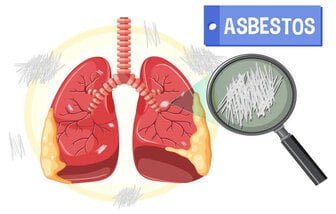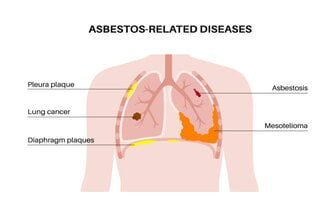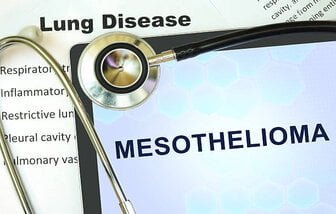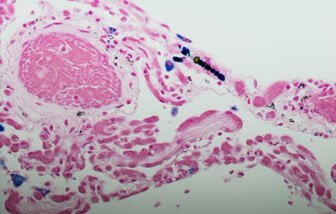Asbestos Lung Cancer
Learn about the dangers of asbestos, a hazardous mineral linked to severe lung diseases such as asbestosis, mesothelioma, and asbestos-related lung cancer. This comprehensive guide covers the symptoms, diagnosis, treatment options, and legal rights for victims, along with preventive measures and resources for affected individuals in the UK. Stay informed to protect your health and understand the legal avenues for compensation.
Understanding Asbestos Lung Cancer in the UK: A Comprehensive Guide
Asbestos is a naturally occurring mineral composed of thin, fibrous crystals. Historically, it has been lauded for its resistance to heat, electricity, and chemical damage, making it an ideal component in a wide array of products and industries.
From the late 19th century to the latter part of the 20th century, asbestos found extensive application in construction materials, automotive parts, textiles, and even household items. Its versatility and durability made it a staple in industries worldwide, including in the UK.
However, the very properties that made asbestos so useful also contribute to its significant health hazards. When materials containing asbestos are disturbed, asbestos fibers can become airborne. Inhalation of these fibers poses severe health risks, as the body’s natural defenses struggle to expel them.
Once inhaled, asbestos fibers can lodge in the lung tissues, leading to inflammation and scarring over time. This can culminate in serious health issues, the most severe of which include asbestosis, mesothelioma, and asbestos lung cancer.
The dangers of asbestos are primarily linked to its fibrous nature. Asbestos fibers are microscopic and can remain suspended in the air for extended periods, increasing the likelihood of inhalation. Once inside the respiratory system, these fibers can cause chronic damage.
The latency period for asbestos-related diseases can be quite long, often taking decades to manifest. This delayed onset complicates diagnosis and treatment, making early detection and awareness crucial.

Exposure to asbestos, a group of minerals made of microscopic fibers, can lead to several serious lung diseases. Among these, asbestos-related lung cancer is particularly concerning due to its severity and complexity. However, it is crucial to understand the spectrum of diseases linked to asbestos exposure to fully grasp the risks and requisite medical attention associated with them.
Mesothelioma is a rare but aggressive cancer that affects the mesothelium, the protective lining covering many internal organs. The most common type is pleural mesothelioma, which impacts the lining of the lungs. Unlike lung cancer, mesothelioma is almost exclusively linked to asbestos exposure. Symptoms often include chest pain, persistent cough, and shortness of breath. Prognosis for mesothelioma is generally poor, with treatment options such as surgery, chemotherapy, and radiation offering limited success.
Asbestosis is a chronic lung disease caused by inhaling asbestos fibers, leading to lung tissue scarring (fibrosis). This condition results in symptoms like breathlessness, persistent dry cough, and chest tightness. Unlike lung cancer, asbestosis is non-malignant but can significantly impair lung function and quality of life. There is no cure for asbestosis, and treatment focuses on symptom management and preventing further damage.
Pleural conditions such as pleural plaques, pleural thickening, and pleural effusion are also associated with asbestos exposure. Pleural plaques are areas of fibrous thickening on the pleura, often asymptomatic but indicative of asbestos exposure. Diffuse pleural thickening involves extensive scarring, leading to reduced lung capacity and breathing difficulties. Pleural effusion, the build-up of fluid between the pleural layers, can cause chest pain and shortness of breath. These conditions vary widely in severity and impact.
In contrast, asbestos-related lung cancer originates within the lung tissues themselves. It shares common symptoms with other lung conditions, such as persistent cough, chest pain, and weight loss, but it is distinct in its malignancy and potential to spread. Treatment often involves surgery, chemotherapy, and radiation therapy, with prognosis depending on the cancer stage at diagnosis.
Understanding these diseases and their differences is crucial for both affected individuals and healthcare professionals, enabling more accurate diagnosis, effective treatment, and improved patient outcomes.
Exposure to asbestos, a group of minerals made of microscopic fibers, can lead to several serious lung diseases. Among these, asbestos-related lung cancer is particularly concerning due to its severity and complexity. However, it is crucial to understand the spectrum of diseases linked to asbestos exposure to fully grasp the risks and requisite medical attention associated with them.
Mesothelioma is a rare but aggressive cancer that affects the mesothelium, the protective lining covering many internal organs. The most common type is pleural mesothelioma, which impacts the lining of the lungs. Unlike lung cancer, mesothelioma is almost exclusively linked to asbestos exposure. Symptoms often include chest pain, persistent cough, and shortness of breath. Prognosis for mesothelioma is generally poor, with treatment options such as surgery, chemotherapy, and radiation offering limited success.
Asbestosis is a chronic lung disease caused by inhaling asbestos fibers, leading to lung tissue scarring (fibrosis). This condition results in symptoms like breathlessness, persistent dry cough, and chest tightness. Unlike lung cancer, asbestosis is non-malignant but can significantly impair lung function and quality of life. There is no cure for asbestosis, and treatment focuses on symptom management and preventing further damage.
Pleural conditions such as pleural plaques, pleural thickening, and pleural effusion are also associated with asbestos exposure. Pleural plaques are areas of fibrous thickening on the pleura, often asymptomatic but indicative of asbestos exposure. Diffuse pleural thickening involves extensive scarring, leading to reduced lung capacity and breathing difficulties. Pleural effusion, the build-up of fluid between the pleural layers, can cause chest pain and shortness of breath. These conditions vary widely in severity and impact.
In contrast, asbestos-related lung cancer originates within the lung tissues themselves. It shares common symptoms with other lung conditions, such as persistent cough, chest pain, and weight loss, but it is distinct in its malignancy and potential to spread. Treatment often involves surgery, chemotherapy, and radiation therapy, with prognosis depending on the cancer stage at diagnosis.
Understanding these diseases and their differences is crucial for both affected individuals and healthcare professionals, enabling more accurate diagnosis, effective treatment, and improved patient outcomes.
Asbestos lung cancer, a serious health condition resulting from prolonged asbestos exposure, manifests through a variety of symptoms. Early detection is crucial for improving treatment outcomes and survival rates. Common symptoms include a persistent cough that does not go away, chest pain that may worsen with deep breathing, coughing, or laughing, and shortness of breath, which can be particularly noticeable during physical activity. Other symptoms might include unexplained weight loss, fatigue, and wheezing.
Individuals who have a history of asbestos exposure should be vigilant about these symptoms and seek medical attention if they experience any of them. Early detection of asbestos lung cancer significantly enhances the effectiveness of treatment options.
Diagnostic procedures for asbestos-related lung cancer typically begin with imaging tests. A chest X-ray can reveal abnormalities in the lungs, while a computed tomography (CT) scan provides more detailed images, allowing for a clearer view of the lung tissue. If these imaging tests suggest the presence of cancer, a biopsy is usually conducted to confirm the diagnosis. During a biopsy, a sample of lung tissue is extracted and examined under a microscope to identify cancer cells.
In addition to imaging and biopsy, pulmonary function tests are often used to assess the impact of the disease on lung capacity and function. These tests measure how well the lungs are working and help in planning appropriate treatment strategies.
Regular health check-ups are essential for individuals at risk of asbestos lung cancer, particularly those with a known history of asbestos exposure. Routine screenings can help detect the disease at an early stage when treatment is more likely to be successful. Health professionals recommend that at-risk individuals discuss their exposure history with their doctors and follow recommended screening guidelines to monitor their lung health proactively.
Asbestos lung cancer, also known as mesothelioma, presents unique challenges in its treatment due to its aggressive nature and the complexities involved. Various treatment options are available to manage this condition, ranging from conventional methods to innovative approaches. Understanding these options is crucial for patients and healthcare providers to make informed decisions.
Surgery is often considered for early-stage asbestos lung cancer. Procedures such as lobectomy, where a lobe of the lung is removed, or pneumonectomy, the removal of an entire lung, may be employed. The goal of surgery is to remove as much of the cancerous tissue as possible, which can potentially lead to remission or a significant reduction in symptoms.
Chemotherapy involves the use of drugs to kill cancer cells. It can be administered before surgery (neoadjuvant therapy) to shrink tumors or after surgery (adjuvant therapy) to eradicate any remaining cancer cells. Common chemotherapy drugs for asbestos lung cancer include pemetrexed and cisplatin. While effective, chemotherapy often comes with side effects such as nausea, fatigue, and hair loss.
Radiation therapy uses high-energy rays to target and destroy cancer cells. It can be used as a primary treatment or in conjunction with surgery and chemotherapy. Radiation therapy is particularly useful for patients who are not candidates for surgery, helping to alleviate pain and control the spread of the disease.
Targeted therapy is a newer approach that involves drugs designed to specifically target cancer cells without affecting normal cells. These therapies work by interfering with specific molecules involved in the growth and spread of cancer. Examples include drugs that inhibit the epidermal growth factor receptor (EGFR) or the anaplastic lymphoma kinase (ALK) pathway, which are often mutated in lung cancer.
Immunotherapy leverages the body’s immune system to fight cancer. Drugs such as checkpoint inhibitors can help the immune system recognize and attack cancer cells more effectively. Immunotherapy has shown promise in treating various cancers, including asbestos lung cancer, offering hope for improved outcomes.
Several factors influence the choice of treatment, including the stage of the cancer, the patient’s overall health, and the presence of specific genetic mutations. Early-stage cancers may be treated more aggressively with surgery and adjuvant therapies, while advanced stages might require a combination of chemotherapy, radiation, and targeted treatments. A multidisciplinary approach involving oncologists, surgeons, and other healthcare professionals is essential to tailor the treatment plan to the individual patient’s needs.
In the UK, stringent regulations and safety measures are in place to prevent asbestos exposure, which is a critical factor in mitigating the risk of asbestos lung cancer. The primary regulatory framework governing the management and control of asbestos is the Control of Asbestos Regulations 2012. These regulations mandate that employers have specific responsibilities to ensure the safety and health of their workforce when dealing with asbestos-containing materials (ACMs).
Employers are required to conduct comprehensive asbestos risk assessments and surveys to identify the presence of ACMs before undertaking any refurbishment or demolition work. These surveys must be carried out by competent and accredited professionals, ensuring thoroughness and accuracy. Once identified, employers must implement a management plan to mitigate the risk of exposure, which includes proper labeling, encapsulation, or, if necessary, removal of ACMs by licensed asbestos removal contractors.
Government agencies, such as the Health and Safety Executive (HSE), play a pivotal role in enforcing these regulations. The HSE conducts inspections and can impose penalties on businesses that fail to comply with asbestos safety standards. Additionally, the HSE provides extensive guidance and resources to help employers and employees understand their obligations and the best practices for managing asbestos safely.
Individuals, particularly those living or working in older buildings, can take proactive steps to minimize their risk of asbestos exposure. It is crucial to avoid disturbing any materials that may contain asbestos, such as insulation, roofing, and floor tiles. If renovation or repair work is necessary, hiring professionals who are trained and certified in asbestos handling is essential. Furthermore, staying informed about the presence of asbestos and regularly monitoring its condition can help prevent accidental exposure.
By adhering to these regulations and safety measures, and through the diligent efforts of government agencies, employers, and individuals, the UK continues to make significant strides in reducing the risk of asbestos-related health issues, including lung cancer.
Individuals diagnosed with asbestos-related lung cancer in the UK have access to a variety of support networks and resources designed to assist them through their journey. These resources provide not only medical and psychological support but also financial assistance and legal guidance, ensuring comprehensive care for affected individuals and their families.
Support groups play a crucial role in offering emotional and psychological support to those impacted by asbestos lung cancer. Organizations like Macmillan Cancer Support and Mesothelioma UK provide platforms where patients and their families can share experiences, receive guidance, and find solace in knowing they are not alone. These groups often organize regular meetings, both in-person and online, facilitating a sense of community and connection.
Counseling services are another vital resource, offering professional mental health support to patients and their loved ones. The British Lung Foundation and Cancer Research UK provide access to trained counselors who specialize in dealing with the emotional toll of cancer diagnoses. These services are essential for helping individuals navigate the complex emotions that accompany such a life-changing diagnosis.
Financial assistance programs are available to help mitigate the economic burden often associated with asbestos-related lung cancer. The UK government offers various benefits, such as the Industrial Injuries Disablement Benefit (IIDB) and the Pneumoconiosis etc. (Workers’ Compensation) Act 1979, which provide financial support to those affected. Additionally, organizations like the Asbestos Victims Support Groups Forum UK can offer guidance on navigating these financial aid options and advise on potential compensation claims.
Legal assistance is also available for individuals seeking compensation due to asbestos exposure. Specialized law firms in the UK, such as Leigh Day and Slater and Gordon, offer expert legal advice and representation for those wishing to pursue claims against employers or manufacturers responsible for asbestos exposure. These legal services can be crucial in securing compensation to cover medical expenses and other related costs.
In conclusion, a plethora of support and resources are available for individuals affected by asbestos-related lung cancer in the UK. By leveraging these networks, patients and their families can find the comprehensive support they need, fostering a sense of community and hope throughout their journey.
Asbestosis Symptoms
Asbestosis is a chronic lung disease primarily caused by prolonged exposure to asbestos fibers. Asbestos, once widely used in construction and various industries due to its fire-resistant properties, poses significant health risks when its fibers are inhaled.
Asbestos-Related Diseases
Learn about asbestos, its industrial uses, and the serious health risks associated with exposure. Discover how to identify asbestos-containing materials, conduct surveys, and implement safety measures to prevent exposure.
Asbestos Lung Cancer
Once inhaled, asbestos fibers can lodge in the lung tissues, leading to inflammation and scarring over time. This can culminate in serious health issues, the most severe of which include asbestosis, mesothelioma, and asbestos lung cancer.
Asbestos Inhalation
Asbestos is a hazardous mineral known for its durability and heat resistance, historically used in various industries. Inhalation of asbestos fibers can lead to severe health issues such as asbestosis, lung cancer, and mesothelioma.
What is Mesothelioma
The most common sites for this malignancy are the pleura (lining of the lungs), peritoneum (lining of the abdomen), and pericardium (lining of the heart). Due to its aggressive nature, mesothelioma poses significant challenges in diagnosis and treatment
Asbestos Compensation
Learn about the dangers of asbestos exposure, the legal framework for seeking compensation, and the types of claims available for asbestos-related illnesses like mesothelioma and asbestosis. Discover how to navigate the claims process
Asbestos & Your Health
Learn about asbestos, a fibrous mineral widely used in construction until it was banned in the UK in 1999 due to significant health risks. Discover the serious conditions such as asbestosis, lung cancer, and mesothelioma caused by asbestos exposure.
Asbestos in Homes
Learn about the risks of asbestos, a hazardous material commonly found in homes. This guide covers the health dangers of asbestos exposure, including asbestosis, lung cancer, and mesothelioma, and provides essential information on proper handling, safety precautions, and professional asbestos removal to safeguard your health and home
What is a Asbestos Surveys
Learn about the different types of asbestos surveys conducted in the UK, including asbestos management surveys, asbestos refurbishment and demolition surveys, and asbestos reinspection surveys. Find out why these surveys are crucial for identifying and managing the presence of asbestos in buildings, and how they ensure the safety.
What is a Pre-Demolition Survey?
A pre-demolition survey is an essential step in any demolition project. By conducting a thorough assessment of the building or structure, potential hazards can be identified and appropriate measures can be taken to ensure a safe and efficient demolition
Refurbishment Survey
A refurbishment survey is a critical step in the refurbishment process in the UK. It helps to identify and manage the risks associated with asbestos-containing materials, ensuring the safety of workers and occupants. By engaging a qualified surveyor to conduct the survey, duty holders
Let's Work Together
Please complete the form below and someone from the Total team will be in touch to discuss your asbestos requirements For urgent needs, our customer support team is available through various channels. You can reach us via phone during business hours, or through our dedicated email support. We are committed to providing timely assistance and ensuring your asbestos concerns are addressed promptly and professionally.











